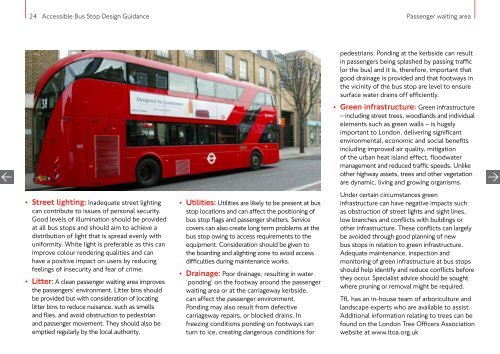ACCESSIBLE BUS STOP DESIGN GUIDANCE
bus-stop-design-guidance
bus-stop-design-guidance
You also want an ePaper? Increase the reach of your titles
YUMPU automatically turns print PDFs into web optimized ePapers that Google loves.
24 Accessible Bus Stop Design Guidance<br />
Passenger waiting area<br />
• Street lighting: Inadequate street lighting<br />
can contribute to issues of personal security.<br />
Good levels of illumination should be provided<br />
at all bus stops and should aim to achieve a<br />
distribution of light that is spread evenly with<br />
uniformity. White light is preferable as this can<br />
improve colour rendering qualities and can<br />
have a positive impact on users by reducing<br />
feelings of insecurity and fear of crime.<br />
• Litter: A clean passenger waiting area improves<br />
the passengers’ environment. Litter bins should<br />
be provided but with consideration of locating<br />
litter bins to reduce nuisance, such as smells<br />
and flies, and avoid obstruction to pedestrian<br />
and passenger movement. They should also be<br />
emptied regularly by the local authority.<br />
• Utilities: Utilities are likely to be present at bus<br />
stop locations and can affect the positioning of<br />
bus stop flags and passenger shelters. Service<br />
covers can also create long term problems at the<br />
bus stop owing to access requirements to the<br />
equipment. Consideration should be given to<br />
the boarding and alighting zone to avoid access<br />
difficulties during maintenance works.<br />
• Drainage: Poor drainage, resulting in water<br />
‘ponding’ on the footway around the passenger<br />
waiting area or at the carriageway kerbside,<br />
can affect the passenger environment.<br />
Ponding may also result from defective<br />
carriageway repairs, or blocked drains. In<br />
freezing conditions ponding on footways can<br />
turn to ice, creating dangerous conditions for<br />
pedestrians. Ponding at the kerbside can result<br />
in passengers being splashed by passing traffic<br />
(or the bus) and it is, therefore, important that<br />
good drainage is provided and that footways in<br />
the vicinity of the bus stop are level to ensure<br />
surface water drains off efficiently.<br />
• Green infrastructure: Green infrastructure<br />
– including street trees, woodlands and individual<br />
elements such as green walls – is hugely<br />
important to London, delivering significant<br />
environmental, economic and social benefits<br />
including improved air quality, mitigation<br />
of the urban heat island effect, floodwater<br />
management and reduced traffic speeds. Unlike<br />
other highway assets, trees and other vegetation<br />
are dynamic, living and growing organisms.<br />
Under certain circumstances green<br />
infrastructure can have negative impacts such<br />
as obstruction of street lights and sight lines,<br />
low branches and conflicts with buildings or<br />
other infrastructure. These conflicts can largely<br />
be avoided through good planning of new<br />
bus stops in relation to green infrastructure.<br />
Adequate maintenance, inspection and<br />
monitoring of green infrastructure at bus stops<br />
should help identify and reduce conflicts before<br />
they occur. Specialist advice should be sought<br />
where pruning or removal might be required.<br />
TfL has an in-house team of arboriculture and<br />
landscape experts who are available to assist.<br />
Additional information relating to trees can be<br />
found on the London Tree Officers Association<br />
website at www.ltoa.org.uk



